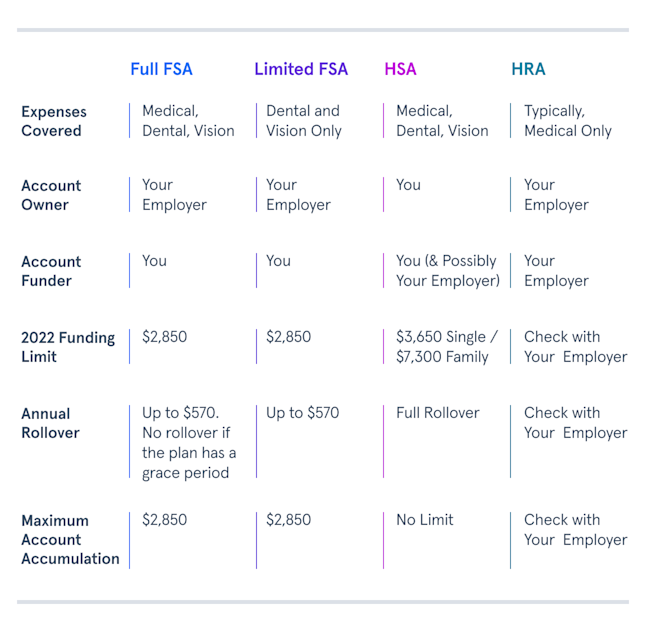
You’ve probably seen health insurance terms like FSA, HSA, and HRA mentioned occasionally, but what does each mean, and how are they different?
Read on to learn more about the similarities and differences between an FSA vs HSA vs HRA. Plus, find out how to pair these pre-tax health spending and savings accounts with your health plan and make them work the best for you.
This article provides a general overview, but there are some specifics you may need to check with your employer or insurer; we've noted those for you.
Key Takeaways
FSA = Flexible Spending Account
HSA = Health Savings Account
HRA = Health Reimbursement Arrangement
What is an FSA?
A Flexible Spending Account (FSA) is funded by you with pre-tax payroll contributions. Most employers do not contribute to your FSA. You can use your Health Care FSA to pay for out-of-pocket health expenses, like your deductibles and copays or coinsurance.
You can use the funds to pay for your own expenses, or those of eligible dependents, even if they are not enrolled in your medical, dental, or vision plan. The annual maximum you can contribute is set by the IRS each year on a calendar year basis. For the calendar year 2022, the most you can contribute is $2,850*.
IRS rules require that funds in the health FSA expire each year, but to help offset the risk of losing money, if you have a balance left at the end of the plan year, your FSA will offer one of two options: Rollover or Grace Period.
Rollover: The rollover limit is also set by the IRS each year. In 2022 (special pandemic-related exceptions aside), if you have funds left in your account at the end of the plan year, your FSA will automatically roll up to $570 into the next year for you. Unfortunately, if you have a balance higher than $570*, anything over that limit will be lost.
Grace Period: If you have funds left in your account at the end of the plan year, you will be able to use those funds for up to 2 ½ months after the plan year ends. As an example, if the plan year ends on 12/31/22, you would be able to access your unused balance for new claims from 1/1/23 - 3/15/23.
There are two types of Health Care FSAs you can have: Full Purpose and Limited Purpose.
Full Purpose Health Care FSA: A Full Purpose Health Care FSA can be used to pay for medical, dental, and vision expenses. This is the most typical type of Health Care FSA offered. It can be paired with most types of employer-sponsored health plans (PPO, POS, HMO) - but you cannot have it if you are contributing to an HSA already.
Limited Purpose Health Care FSA: If you have an IRS-Qualified High Deductible Health Plan and are contributing to an HSA, you can still have a Health Care FSA, but it will be limited to dental and vision plan expenses only.
FSA Key Takeaways:
Account owner: Your employer
Account funder: You
Account funding limit: $2,850 in 2022
Annual rollover or grace period: Check with your employer or plan administrator
Account funds paid automatically or your choice: Your choice
Leaving your employer: Funds are forfeited
What is an HSA?
A Health Savings Account (HSA) is an actual bank account that is only available to participants enrolled in a Qualified High Deductible Health Plan. The IRS sets the rules which determine whether a plan is “Qualified”, how much can be put into the account each year, whether you are eligible to make and/or receive contributions to this type of bank account, and:
You must be actively enrolled in a Qualified High Deductible Health Plan (these plans have minimum levels of deductibles required by the IRS and you must meet the deductible before the plan pays for any non-preventive claims)
You cannot have any other type of health coverage that would pay non-preventive care claims before you meet a deductible
You must not be enrolled in Medicare
You must not be able to be claimed as a dependent on someone else’s tax return
An HSA can be used to pay for health expenses for yourself and eligible dependents just like an FSA, but it has a much higher contribution limit and you don’t lose any funds at the end of the plan year.
An HSA Has a Triple Tax Advantage
Money goes into the account, earns interest, and comes out of the account all on a federal tax-free basis, as long as the distributions are used for qualifying medical expenses (NJ and CA do not currently offer tax-free contributions at the state level; check with your tax advisor). If you change health plans in the future or even if you leave your employer, the money stays with you.
The most that can be contributed to an HSA in the calendar year 2022 is $3,650 if you have single coverage and $7,300 if you have family coverage. Your employer may also make contributions to your HSA, so be sure that contributions from all sources do not exceed the limit.
Excess contributions must be removed from the account or they will be subject to regular federal income tax, plus a 6% penalty.
Eligibility to make contributions to an HSA is determined as of the 1st of each month. If you become eligible to make HSA contributions mid-year, you may choose to pro-rate your contributions to ensure that you do not exceed the annual limit.
For example, if you become eligible on 6/1 and have single coverage, you would be able to contribute a maximum of $1,825 in 2022, equal to 6 months’ worth of maximum contributions.
However, the IRS does allow you to contribute the full maximum even if you become eligible for mid-year - but you must remain enrolled in a qualified high deductible health plan through the December 31st of the next year (in this example, you would need to remain enrolled through 12/31/23).
If you are age 55 or older, you can contribute an extra $1,000 in “catch up” contributions each year.
You Control How the Account is Funded
You can make uniform contributions each paycheck, make a larger upfront contribution, or you can change your contributions each month if you wish. You decide if and when to use the funds in your account. You also have the option to use them throughout the year to help pay for out-of-pocket expenses, or you can save them for the future – even into your retirement – because the funds roll over every year and there is no limit to how much you can accumulate over time.
Often, once your account reaches a minimum threshold, you can access investment options as well; check with your HSA administrator on that. You can reimburse yourself at any time in the future for an expense incurred while you were eligible to contribute to an HSA – so save those receipts.
HSA Key Takeaways:
Account owner: You
Account funder: You (but check with your employer to see if they also fund)
Account funding limit: $3,650 if you have single coverage and $7,300 if you have family coverage in 2022
Annual rollover of extra funds: All funds rollover
Maximum account accumulation: No limit
Account funds paid automatically or your choice: Your choice
Changing health plans: If you change from a High Deductible Health Plan to another type of health plan, you can no longer contribute to the account, but you will always have access to the funds and can use them for qualified health expenses
Leaving your employer: Funds go with you
What is an HRA?
A Health Reimbursement Arrangement (HRA) is often directly linked to a particular medical insurance plan (meaning, it is attached to your health plan and is administered by the medical carrier), although there are standalone types of accounts as well, where the account is administered by a third party, not by the insurance carrier.
This type of account is funded by and owned by your employer; you cannot contribute money to it. Your employer determines how much money is deposited into your account each year.
Think of this type of account as a “virtual account”: you only have access to the funds if and when you have qualified health claims to file against it. If you have funds left in your account at the end of the plan year, typically, they will roll forward to the next year, but there is often a limit on what can roll forward and how much can accumulate in the account.
If the account is directly linked to the insurance carrier: It will only cover expenses incurred on that particular plan and it cannot be used for other health expenses as defined by the IRS (for example, dental expenses or medical expenses that are not covered by the plan, like elective surgeries or excluded prescriptions).
Typically, funds are automatically paid out of this account when you have covered expenses, but your employer may allow you to choose if and when to use your funds to reimburse yourself.
If your HRA is a standalone account: You have the choice of if and when you wish to use the funds to pay for covered expenses and you can use them for all health expenses as defined by the IRS.
If you leave your employer or change medical plans, the account funds are forfeited.
HRA Key Takeaways:
Account owner: Your employer
Annual funder: Your employer
Account funding limit: Check with your employer or insurer
Annual rollover of extra funds: Check with your employer or insurer
Maximum account accumulation: Check with your employer or insurer
Account funds paid automatically or your choice: Check with your employer or insurer
Changing health plans: Check with your employer or insurer; if the HRA is linked to the underlying health plan, funds are lost. If the HRA is administered by a third party, you may still be able to use them with another health plan at your employer
Leaving your employer: Funds are forfeited

We hope that this overview about the similarities and differences in FSA vs HSA vs HRA has given you the information you need to understand what might work best for you and your family and to be comfortable taking a closer look at the options available to you through your employer.
*Special COVID-19 related legislation allows for temporary increases in elections and rollover balances through 2022. Adoption of these special changes is at the discretion of each plan sponsor, so please check with your employer to see if your election can be higher than $2,850 and if your rollover can be higher than $570.







